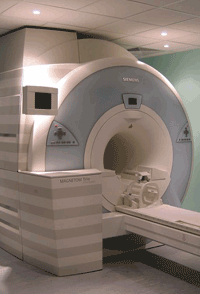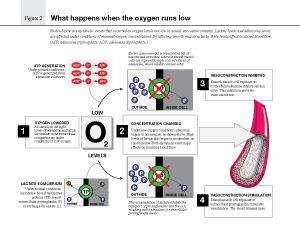Publication
Article
Psychiatric Times
Functional Magnetic Resonance Imaging: Round 2
Author(s):
This is the second installment in a 3-part series that discusses some of the mechanisms behind functional magnetic resonance imaging (fMRI) technology. As you may recall, the genesis for this series was reactive…I got mad while sitting on an airplane reading a magazine article about how fMRIs can predict everything from product preferences to political inclination. The article hinted at something I have been noticing with increasing alarm-the confusion about what fMRI can and cannot reveal about information processing in the brain. I decided to write this series hoping that knowledge of the basic science behind fMRI technology could contribute to making more nuanced conclusions about the data it reveals.

This is the second installment in a 3-part series (read 1st column here) that discusses some of the mechanisms behind functional magnetic resonance imaging (fMRI) technology. As you may recall, the genesis for this series was reactive…I got mad while sitting on an airplane reading a magazine article about how fMRIs can predict everything from product preferences to political inclination. The article hinted at something I have been noticing with increasing alarm-the confusion about what fMRI can and cannot reveal about information processing in the brain. I decided to write this series hoping that knowledge of the basic science behind fMRI technology could contribute to making more nuanced conclusions about the data it reveals.
Last month, I discussed some of the basic physics behind MRI and described why magnets and radio waves were so important in getting an image. Here I explore how that physics reveals neural activity in the brain. Actually, fMRI does not detect neural activity at all. It only detects changes in blood flow, which may be a source of some of the confusion (more on that in a moment).
To talk about the controversies about what fMRI actually detects (and yes, there are controversies), I will briefly describe the relationship between neural activity and the brain’s hemodynamic properties. I will then move to data that appear to describe the molecular components behind this relationship. Along the way, I will review some basic biochemistry, from glycolysis (remember glycolysis?) to the prostaglandin biosynthetic pathway.
Detecting basics
The basic idea behind fMRI and brain activity is simple: when busy brain tissues are processing information, they naturally require more energy than when they are not processing information. At its most atomic level, the activity involves the translocation of ions across cell membranes. To generate the energy needed to pump ions out, neurons need a ready supply of blood-borne glucose and oxygen. Why blood-borne? As you know, neurons do not possess internal energy stores in the form of oxygen and glucose. Any increase in their activity requires dipping into extracellular energy resources. Increasing energy supply is supposed to mean increasing blood flow to the neural tissues that need it.
"Noninvasive imaging, such as fMRI, is a great and powerful technology, but it provides no easy answers in our quest to understand how the brain processes information."
This link between energy needs and blood flow is fundamental to our story: fMRI machines can only detect localized changes in blood flow. The phenomenon is known as a BOLD (blood-oxygen level–dependent) signal. How is a machine that traffics in magnetic fields and radio waves capable of detecting changes in blood flow in the first place? You’ve known the answer since grade school. Hemoglobin-bound iron atoms are found in blood, and because these atoms are metal they are magnetically sensitive. Localized oxygen release is of course greater for actively depolarizing neurons than for inactive neurons. And it is this difference that drives the BOLD signal. There is thus a conceptual link between neural activity and the hemodynamic properties of the brain.
At least we think so. The association with blood flow and neural activity is actually not as clear as is sometimes thought. Two examples come to mind. First, increased neural activity does not always result in an increased hemodynamic signal. There are studies that show that increased neural activity can sometimes result in localized vasoconstriction, not dilation, which creates a reduction in localized blood flow.
A second example comes from an issue that is often glaringly omitted from discussions about brain activity: the role of controlled neural in-hibition. Certain types of processing require a deliberate and sustained quelling of regional neural activity. Such deliberate inhibition requires an increase in energy supply, just as deliberate activation does. How does an fMRI signal, which can only detect increases in blood flow, discriminate between these 2 powerful processes? The short answer is that it sometimes cannot.
Questions can even arise from application. There certainly are data that support a positive correlation of blood flow with neural activity. However, what activity is being measured may depend on experimental design. In some cases, increased blood flow signals an anticipatory rather than a reactive response. In one experiment, participants started showing increases in anticipation of the onset of a specific task before the task had even begun. The experimenters concluded that getting a signal concordant with the task depends on the type and timing of the activity.
Does that mean we should just throw out the idea that neural activity and blood flow are positively correlated? Hardly. All it suggests is that we need a more nuanced understanding of the relationship between the two.
What is needed is a more detailed understanding about the link between neural activation and blood flow. That suggests a relationship between cell populations, from brain cells to smooth muscle cells. (After all, it is the vasodilation or vasoconstriction of these encircling muscle cells that ultimately controls localized changes in blood flow, and thus the BOLD signal). That means understanding the mechanisms that can coax more energy out of the system . . . perhaps in reaction to some “depleting signal,” such as a loss of localized oxygen concentration, or a level below some critical threshold, or blood vessel involvement.
Happily, our understanding of this relationship is becoming clearer. It is now evident that there exists an array of switching mechanisms that can promote brain energy supply-some that use localized oxygen levels as their guide. Though the story is somewhat complicated, it is well worth the journey.
Figures 1 and2 assist in understanding this biochemical mechanism. These data give just one view of the complex relationship between blood flow and neural activity and show both the enthusiasms-and the cautions-that one must deploy when interpreting fMRI signals.
Of astrocytes, glycolysis, and blood flow
Much of our story involves metabolic processes that occur in astrocytes. Astrocytes are an important member of the glial cell population, a community made up of about 90% of all cells in the brain.
For many years, glial cells were thought to play only a supporting structural role in brain biology (indeed, the word glial means “glue”). We don’t think that anymore, and the signal processing discussed below is a good example of why we’ve had to change our minds. Neurons need oxygen and glucose to function, and their delivery is regulated by glial cells. Astrocytes provide key metabolic support for busy neurons by increasing the availability of glucose and trafficking the energy supply through a vast network of connecting cells.
Our story begins by examining what happens to energy processing and vascular behavior under conditions when oxygen levels are low. Energy is derived from this activity via glycolysis (ie, the Embden-Meyerhof pathway).
Many important metabolic events are stimulated if localized oxygen levels drop below a certain threshold. Excess extracellular lactate levels rise, as do intracellular concentrations of adenosine. (This is because there is insufficient energy to make adenosine triphosphate [ATP], resulting in the accumulation of precursors).
It has recently been shown that what cells do with this surplus of lactate and adenosine assists in regulating blood flow to the area in which the surplus occurs. Indeed, these metabolic by-products have direct effects on the behavior of blood vessels. To help understand that relationship, we also need to review a few molecular facts about vasodilation and vasoconstriction.
Blood flow is obviously controlled by either relaxing or constricting local arterioles in the brain, which means interacting with the brain’s smooth muscle cells. One way to induce constriction in these cells is to increase calcium influx, which occurs via the muscle’s voltage-gated channels. If this entry is inhibited, the constriction does not occur. Predicting whether relaxation or dilation occurs depends in part on understanding the signals that regulate calcium entry into smooth muscle cells (Figure 1).

Prostaglandin is involved in these processes. Prostaglandin is made from arachidonic acid, itself generated from membrane lipids inside astrocytes. Prostaglandins are classic vasodilators and exert such power that their local concentrations have to be tightly regulated. This control is activated via transporter proteins embedded in cell membranes. Acting like finicky gatekeepers, these proteins can either allow prostaglandins entrance, which reduces their extracellular concentration, or keep them out, which elevates extracellular concentrations. Interestingly, these fin-icky gatekeepers need to be “bribed” (stimulated) to get them to work. This bribing occurs via a series of controlled molecular exchanges and plays an important part in our blood-flow controlling story.
Arachidonic acid by-products don’t always display vasodilating activity. If arachidonic acid does not convert to prostaglandin, you can get it to work like a vasoconstrictor. It has to hang around long enough to diffuse into the encircling smooth muscle cells. If it does, the acid becomes transformed into a derivative called 20-HETE, which has powerful vasoconstricting properties. The system thus works in a straightforward manner. Whether blood flow is increased or decreased depends on what the originating cell decides to do with arachidonic acid.
A critical question emerges: what causes arachidonic acid to be made from membrane lipids in the first place? The answer is: active neurons. It turns out that excitable neurons control their energy supplies by incessantly sending regulatory signals to their local supporting astrocyte network. These signals are carried via the neurotransmitter glutamate, which, when released from activated neurons, raises internal glial calcium ion concentrations. This rise in calcium stimulates astrocytes to synthesize arachidonic acid from their cell membranes. This role forms a critical molecular link between neural activation and blood flow.
While raising internal calcium concentrations will certainly give astrocytes lots of arachidonic acid, it hardly answers the question about control. What coaxes the arachidonic acid to take either the pathway toward relaxation or constriction? To answer, I need to return to the 2 molecules whose extracellular concentration rises in response to low oxygen levels, adenosine and the tightly regulated prostaglandin (Figure 2).
Adenosine levels rise in brain cells bathed in a low-oxygen environment (they can’t generate ATP). What neurons and astrocytes do with this excess adenosine is to treat it like any toxic waste: they transport it outside their cytosols. This transport to the extracellular compartment immediately exposes the adenosine to arteriole smooth muscle cells. The exposure has a remarkable effect. Excess adenosine prevents calcium from entering smooth muscle cells through their voltage-gated channels. The prevention of calcium into smooth muscle is interpreted by those cells as a “do not constrict” signal. The muscle obeys, and stays open for business. This naturally creates a change in blood flow.

But that’s not all that happens. Low oxygen concentrations create an increased presence of lactate and prostaglandins can be transported in and out of cells by finicky membrane-bound transporter proteins. I used the word “bribe” to describe an interesting exchange between lactate and prostaglandin. If there is a small amount of extracellular lactate, the cell is glad to exchange it for pros-taglandin, vacuuming up extracellular prostaglandins and forcing the vasodilator to reside in the cytosol. But it is a finicky gatekeeper. If there is too much extracellular lactate (as always exists in an oxygen-poor environment because of increased energy generation by glycolysis), the transporter refuses to keep up the exchange. As a result, prostaglandin is forced to stay outside.
And what does prostaglandin do in the extracellular space? Prostaglandin, the archetypal vasodilator, coaxes the arterioles to open up.
This is an extraordinary finding. Low concentrations of oxygen inhibit vasoconstriction (via excess extracellular adenosine) and simultaneously stimulate vasodilation (via excess extracellular prostaglandin). The link between energy use and arteriole diameter has an explanation at the molecular level.
Conclusions
Although these data support the notion that blood flow and neural activity are positively correlated, many questions about fMRI remain. Could the low levels of oxygen concentration that accompany neural activity perturb the astrocyte network with sufficient speed to generate the hemo-dynamic changes seen when using fMRI? The answer awaits further research. We know that there is a substantial delay (about 5 seconds) between neural activity and observed changes in blood flow.
Another question is more fundamental. How do we integrate this detailed blood-flow promoting system with some of the other data mentioned earlier-such as activity also capable of promoting vasoconstriction? And what about inhibition? Because of space limitations, I did not discuss other systems that can regulate blood flow and are also involved in glutamate metabolism (such as nitric oxide, a molecule also released by active neurons and possessing powerful blood-flow regulating capac-ities). The bottom line is that there appear to be many switching mechanisms. We are just beginning to characterize a few of them. A complete picture will have to involve a description of how all these switches interact.
This lack of data forms the core of why we must be cautious when interpreting fMRI. It is not as simple as saying increased blood supply means increased neural activity. Although many studies suggest a positive correlation, there is no full explanation of the relationship, which suggests a need for prudence.
I will have much more to say about being cautious when viewing fMRI data in the final installment on this topic. Noninvasive imaging, such as fMRI, is a great and powerful technology, but it provides no easy answers in our quest to understand how the brain processes information.






